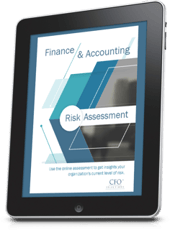Risk Management Planning is Responsible for Developing the Business Continuity Plans
Related posts
Topics: Planning, Risk Management, Transition
Source: https://www.cfoselections.com/perspective/business-continuity-planning-and-risk-management
One of your most important tasks as a business leader and manager is mitigating risk. Understanding what kind of risk exists, planning for the impact of this risk, and executing continuity plans to keep the organization operational during a disruption is of paramount importance. The earlier risk can be identified, assessed, managed, and integrated into strategic planning, the better. Typically, this burden falls on the C-Suite, but leaders at all levels should be included in the planning stage to ensure buy-in across the company. According to CFO Magazine, CFOs have seen risk management fall under their umbrella more over the last decade. They explain, "The CFO's role has expanded in recent years, perhaps most notably in the area of risk management. Finance chiefs frequently took charge of assessing and guarding against risk during the financial crisis, and as the economy has slowly recovered, few have relinquished the task. More than half of the finance executives responding to CFO's latest Deep Dive Survey say their responsibility for risk management has increased." Not much has changed in the years since, with CFOs taking more ownership of risk than ever before, whether they want to spearhead this role or not. While it is easy to task an individual with overseeing risk management, ideally, it should not roll up to a single person. An emphasis on risk mitigation should be ingrained across the organization with alignment and compliance at every level. CFOs leading the charge can get their organizations on board to share the responsibility by taking a four-step approach to business continuity planning. The cornerstone of risk management is identifying all possible risk scenarios. Knowing what kind of risk exists sets a foundation for business continuity planning. Risk can come from inside or outside an organization, and falls within four main areas: A CFO must help business leaders identify risk and understand the scope of these risks by classifying and triaging them to know how best to respond. Organizations accustomed to focusing solely on financial risk may need to be recalibrated to expand their risk horizon view. The goal is for a CFO to insure the business against adverse outcomes by planning for a wide variety of risk factors. Maintaining financial reserves is one of the best ways for organizations to protect themselves against not only financial risk, but also operational and catastrophic risks. As the financial head of the company, a CFO is uniquely positioned to manage this initiative. Additionally, a CFO has the skillset needed to model how the business will respond strategically to moderately or highly probable risks. Continuity planning will reduce your subsequent financial and operational impacts. Reassess to update risk probabilities and impact scenarios periodically. While a CFO can oversee risk management, one person cannot be tasked with understanding every possible risk area when other individuals are closer to a threat. Widespread adoption of risk management enables continuous risk management, equipping your business to act swiftly when a possible risk turns into a reality. Empower employees company-wide to identify possible risks and ensure the proper chain of command is in place to get information to analysts and key decision-makers quickly. When feedback is coming from employees on the front-line, take it seriously and track it to identify emerging trends. Where credible risk exists, weave it into your organization's risk mitigation efforts, and give credit to the individuals or teams responsible for identifying it. Protect (and even reward) employees who report risk to encourage ongoing contribution at all levels. Use our free financial risk assessment tool to understand where your organization stands. This assessment can help you develop a plan to manage business risk and mitigate its impact. A financial risk assessment can make all the difference for your business. Preparing to take advantage of opportunities and eliminate potential landmines makes good business sense. Get instant access to our free finance and accounting risk assessment here! 
Identify Risk Factors
Plan to Mitigate Risks
Continuously Monitor Risks
Report and Track Risk Levels

Topics: Planning, Risk Management, Transition
Source: https://www.cfoselections.com/perspective/business-continuity-planning-and-risk-management
0 Response to "Risk Management Planning is Responsible for Developing the Business Continuity Plans"
Post a Comment